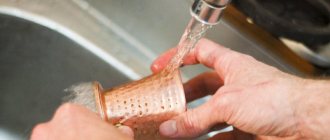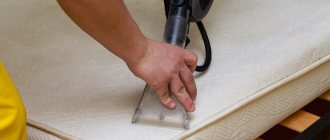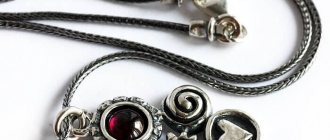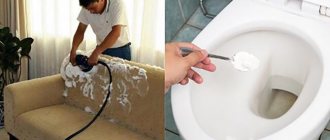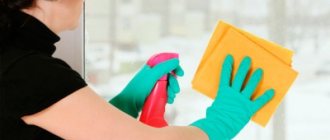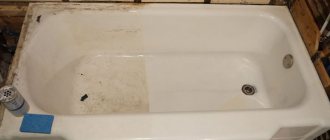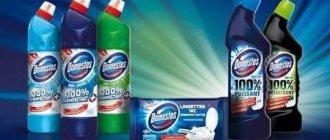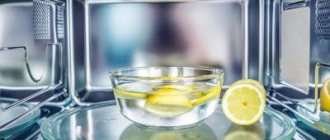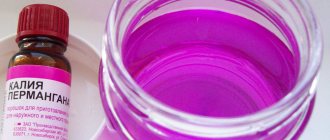There are many products for cleaning any surface in the house, including the bathroom. But they are expensive and often contain harsh chemicals that can be dangerous to humans. Therefore, many housewives today are returning to natural remedies and are interested in questions about how to clean the bathtub at home with soda and vinegar and whether it is possible to achieve radiant whiteness using a mixture of similar products.
Types of pollution
A bathtub is a household item that people use every day, so keeping it clean is important. On the Internet you can find hundreds of videos demonstrating how yellowed enamel, after treatment with a special product, becomes snow-white in a second. But the choice of cleaning method depends on the origin of the contaminants.
- The most common is soap scum: soap particles settle on the walls after water procedures. Such stains can be easily washed off with hot water.
- If water with increased hardness flows from the tap, then limestone deposits gradually form on the walls of the bathtub.
- Dark stains and stains on the surface may be associated with intensive growth of fungi, because the conditions of the bathroom are conducive to the growth of pathogenic microbes (it is quite warm and humid here). In such a situation, thorough disinfection is required.
- The formation of orange, reddish and yellow deposits is often associated with increased iron content in the water. It is much more difficult to get rid of it.
Hydrogen peroxide, sodium bicarbonate against rust stains
The combination of hydrogen peroxide and sodium bicarbonate will help deal with rust, restore the whiteness of plumbing fixtures, and remove stubborn lime stains. The product can be used even on delicate surfaces - the active components do not harm the coatings.
Preparation, use:
- Combine sodium bicarbonate (30 g), hydrogen peroxide (15 ml).
- Leave after stirring for a quarter of an hour.
- Apply the mixture to the surface and spread in an even layer.
- Leave for half an hour.
- Apply the treatment with a sponge, rub too stubborn stains additionally, if necessary, use a brush with stiff bristles.
- Rinse and thoroughly rinse off any remaining alkaline solution.
Wipe the surface and polish if necessary.
The effectiveness of soda and vinegar
Vinegar and soda are natural, completely safe means that you can use to keep your home tidy and clean. These two components:
- have antiseptic properties, provide mild disinfection;
- prevent the proliferation of fungal and bacterial microorganisms;
- dissolve lime, quickly but gently remove dirt from different surfaces;
- eliminates unpleasant odor.
It is possible to wash the bathtub with soda and vinegar, but for this it is recommended to clean its surface 2-3 times a month, because the longer the stains remain on the enamel, the faster they eat into and the more difficult it is to remove.
Alternative to household chemicals
Retail establishments offer an expanded range of products designed to clean various surfaces. If your plumbing products become dirty, you can purchase effective products that make it easy to quickly remove stains and remove traces of rust.
However, in this case you have to bear additional financial costs. Sometimes, unfortunately, popular products are accompanied by a high cost, so they are inaccessible to some housewives.
In addition, such chemicals can cause health problems. Even minor residues of aggressive agents upon contact with hot water can negatively affect the overall well-being and condition of the skin. Household chemicals are especially dangerous for people with a tendency to allergic rashes.
Fortunately, there are alternative methods for cleaning plumbing products that you can prepare yourself at home.
Moreover, their effectiveness is no worse than store-bought products.
Baking soda or ash
When choosing a bath care product, you need to pay attention to the type and intensity of dirt. Baking soda is slightly alkaline. The powder is suitable for removing light stains. It is safe for bathtub enamel and is not capable of harming human health, but gloves should still be worn.
To remove old, stubborn dirt, it is better to use soda ash. This is a strong alkali that can remove both rust and limestone deposits, but when using it you must take safety precautions: gloves and a respirator are required, as otherwise allergic reactions are possible.
Ammonia, sodium bicarbonate against stains, yellowness
Expert opinion
Did you know?
Using a mixture of ammonia and sodium bicarbonate against yellowness is a quick way to return the bathtub to its original whiteness and shine. The process is no different from using other solutions based on baking soda.
Preparation, use:
- Mix sodium bicarbonate (55 g), ammonia (20 ml).
- Stir until smooth and foam disappears.
- Spread the paste in a thin layer over the surface.
- Leave for 15-20 minutes.
- Wipe with a sponge, especially vigorously treat dirt, lime stains, and yellow discoloration. It is not recommended to use hard brushes - they can easily cause scratches.
Wash the surface with water, use only warm liquid. Complete the process by removing residual moisture; you will not need to use special preparations for polishing - the mixture will return shine and whiteness.
Recommended for you:
How to prepare and use soap and soda solution
Instructions for cleaning the bathroom with a mixture of baking soda and vinegar
You can clean your bathtub by following a simple recipe.
- Soak a soft sponge in clean water and squeeze out. With its help, soda powder is applied to the walls of the bath.
- Dilute vinegar with water and pour the liquid into a spray bottle. Now you need to spray the solution over the baking soda. Both components will enter into a chemical reaction, accompanied by characteristic hissing and the formation of bubbles.
- The mixture should remain on the contaminated surface for 15 minutes.
- After this, use a sponge to rub the mixture over the walls of the bath again. If you leave the product on the surface for another 15 minutes, the bath will turn white again.
- The final stage is to thoroughly rinse the walls with warm running water.
- You should not leave the bath wet; it is better to wipe it with a clean cloth, so the effect will last longer.
How to remove slight sediment on bathroom walls
How to clean a bathtub from yellowness and remove soap and limescale deposits if the contamination is insignificant? A few tablespoons of baking soda is enough.
- Rub baking soda over the surface of the plumbing fixtures with a damp foam sponge or soft brush. Pay special attention to “problem” areas: carefully rub off stains and any yellowish discoloration. Then leave the bath for about an hour, then wipe again, thereby removing any remaining dirt, and rinse the surface with warm water.
If you clean your bathtub with baking soda regularly, the enamel will remain white and sparkling for a long time.
Separate use
The ingredients can be used separately. The baking soda method is no less effective. You need to dilute the powder with warm water until you get a paste.
The product is distributed with a soft sponge over the walls of the bath, where it remains for 1-1.5 hours. After this, the remaining soda should be wiped off with a napkin, and the surface should be rinsed with water and dried.
If you don't have vinegar in the house or you don't like the pungent smell of the liquid, you can clean the bathtub with soda and citric acid. The application method is as follows:
- First, a soda paste is applied to the surface (it must be left for 20 minutes);
- During this time, you need to dilute citric acid in warm water;
- the walls of the bath are sprayed with the resulting mixture (the acid reacts with soda);
- After 10 minutes, the remaining cleaning agent can be washed off.
There is another effective composition - soda and laundry soap. The recipe for the product is simple: you need to dissolve 75 g of powder and 100 g of soap (to simplify the procedure, you can grate it on a coarse grater) in 1-2 glasses of water. The paste is applied to the surface of the bathtub and tiles for 30-40 minutes, after which it must be rinsed off.
Sometimes it is not possible to get rid of yellow spots using the methods described above. In such a situation, you can use bleach. Any product containing chlorine will do (particularly clothing stain removers). This liquid quickly removes dirt and disinfects the surface, but it is better to handle the bath with gloves and a respirator, since chlorine is toxic.
How to clean sealant?
A thin layer of sealant is removed with chemicals. Regular gasoline, acetone or thinner will do. It is better to use factory products that are more effective. They are produced in the form:
- liquid mixture;
- foam;
- aerosol;
- pasta.
One of these drugs is applied to problem areas, and after a while it is washed off with water. Each of these products comes with instructions.
A layer of sealant that is too thick will have to be removed mechanically. To do this, use a scraper or spatula, and the residues are cleaned using the listed means.
The essence of the method?
Baking soda, or sodium bicarbonate, is a white powder that is highly absorbent (Figure 1). Its grains absorb dirt without damaging surfaces or leaving scratches. This substance is worth choosing to clean your bathtub for several reasons:
- mild effect - soda does not contain insoluble particles hazardous to human skin;
- efficiency - with the help of this powder you can remove even old plaque and rust;
- removing unpleasant odors - baking soda neutralizes odors, rather than simply masking them with flavors.
Baking soda is hypoallergenic, so it can be used to clean bathtubs for people with sensitive skin. In addition, it is recommended to use it for washing baby baths.
Figure 1 - baking soda in standard packaging
Precautionary measures
All work must be carried out with gloves.
When using soda ash, you need to be especially careful and follow safety precautions. After all, it is a chemical product, therefore, like any drug, it should be stored in places separate from food storage, and also inaccessible to children and animals.
Before cleaning the surface, you must purchase rubber gloves and work only in them. This is especially true for those who have sensitive hand skin. If you use it for washing, you should not forget that this substance can corrode fabrics, so you must strictly adhere to the time regime. If, while working with soda, it gets into your eyes, you should quickly rinse them with plenty of water, and in case of severe irritation, consult a doctor.
This substance is purchased in hardware stores - household chemicals departments. As a rule, it is located near washing powders and other detergents.
